The leaders’ gold and silver medals rested on the side of the awards table unperturbed. “Fast Eddie” Rousseau, pacing the lead on a February day, was on mile 70 of the 2019 USA Track & Field (USATF) 100-Mile Nationals in Las Vegas. Suddenly, he suffered The Lean’s impact, which determined the outcome of this challenging ultradistance event. Unfortunately, many lead competitors fall under this spell afflicting senior athletes.
About “The Lean”
The Lean, (aka stooping, slumping, humped-over) is an athlete’s burden. The condition is when one’s back slumps forward or bends sideways while the shoulders cave forward, and it seems commonplace among senior athletes. You know it when you see it, mostly in seniors over age 70.
Creating a unique set of problems, the Lean influences outcomes in competitions because of the wear and tear on the competitor and pain from attempting to complete the distance while battling to outlast the problem.
Oh, you’re not that age, this doesn’t pertain to you? Wrong, straight-back. Get there, first-of-all, then you’ll know what’s cooking, or should I say slumping? Why should you care? Because with luck and good habits you’ll live that long. If left unchecked, The Lean will impact your life outside of athletic endeavors, perhaps in a severe way.
Investigating The Lean For Senior Athletes
Chased by noted senior endurance athlete and the 2018 age-class gold medalist for this desert race, David Blaylock, “Fast Eddie” Rousseau exclaimed, “We both got the dreaded leans.” Minnesota’s well-known champion at many events and distances over the decades battled his competition and friend. “Finally, he actually fell at the aid station and dropped out. Without him pushing me, I let the lean-pain slow me so much that at 88 miles (141 km), I was missing the cutoff and also had to drop.”
The nemesis of senior athletes, both in their 70s, The Lean snatched those medals away from them and proudly stored them in its affliction-warehouse. If one ever gazed inside, the view would be of awards stacked and decaying, each full of memories of what might have been.
The lean scene becomes another difficulty the master endurance athlete endures while covering those long ultra miles on trails, roads, snowshoes, or skis. Thus, we decided to delve deep into this subject. We wanted to find solutions with input from global experts and those who can offer methods to deal with “The Lean.” Then, we want to make them known. You can join us in that process.
Which works for you? The best approach, pick one or two and get started. Try them all. While you’re at it, let others know what you discovered.
Table of Contents For Approaches
- Pushing The Wall
- Efficient Use Of Energy
- The Lovy Technique: Pressure On The Gluteus Muscles
- The Backward Stretch
- Anatomical Dysfunction: Lifestyle, Nutrition, Inversion
- Using Kettlebells
Approach 1: Pushing the Wall By Dr. Casey Moore
Dr. Casey Moore, founder of Moore Chiropractic: A Family Wellness Center, begins his discussion of The Lean. “It used to be that the ‘posture’ concern was slouching and having your mother or grandmother say to sit up straight… Now, with technology ever-present, particularly smartphones, our posture concern is now a forward ‘lean” as opposed to a slouch.”
Becoming Aware
Dr. Moore notes the impact The Lean can have on our bodies for all ages. “Our postures have begun to lean forward, starting with the head and neck, and ultimately leading to a full upper body lean out over our legs. This new posture creates a tremendous amount of strain initially on our lower neck. [Moreover], the further the lean progresses, the more it moves down the spine from the mid to ultimately the lower.”
He continues, “As a chiropractor (officed in Edina, Minnesota), I am seeing this effect in younger and younger ages with now, after ten years in practice, seeing a drastic increase in headaches and neck issues in children and teens. The biggest key to avoidance of this issue is simply awareness. Then once aware of the issue, you have the ability to stop the progression of it and begin to reverse it with some simple exercises.”
Exercises To Help The Lean
Dr. Moore shares his advice for senior athletes afflicted with The Lean. He notes that “The easiest [exercise] is routinely checking or correcting the issue by standing with your back and heels to the wall. [Then], pull your posture up and back such that your shoulders and head also come in contact with the wall. You can treat this activity like any other stretch or exercise by holding the proper position for 30 seconds, relaxing then repeating. This [exercise] can and should be done throughout the day, particularly for those spending hours behind a computer, tablet, or cell phone.”
The activity might seem simplistic, especially for senior endurance athletes, but not once you begin using it. You will feel it, particularly in your weaker areas.
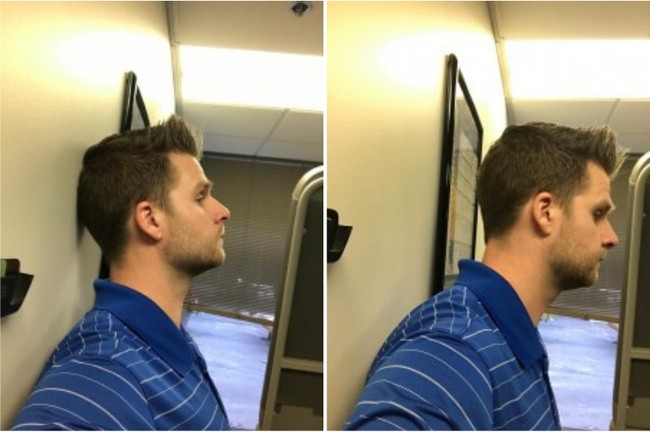
On left: The exercise to cure, stand with heels against the wall with shoulders and head touching the wall. On Right: Dr. Casey Moore demonstrating the rounding of shoulders, neck extension. Photo: Dr. Casey Moore.
Approach 2: Efficient Use of Energy By Dr. Lucas MacMillan
Dr. Lucas MacMillan is a naturopathic physician in North Vancouver, B.C. Canada and shares his knowledge on how to have a healthier back. He used references to the book ProHealth Systems where he is also a contributing author. Dr. MacMillan says, “I included an image (see below) showing that different postures affect our backs to differing extents – it speaks to the pressure on our spinal disks when laying down, standing, hunching, etc. Here are the points that I feel are worth focusing on.”
Remaining Efficient
To help stay injury-free and enjoy life long-running or your chosen sport, Dr. MacMillan says, “Efficiency–our best athletic performances require efficient uses of energy. If we are using energy inefficiently, we will get tired faster. To exaggerate this, imagine cross country skiing with knees always bent to 90 degrees. We would tire incredibly fast, because our muscles are doing all of the work, rather than standing more upright and using our bone structure to keep us up, which takes very little energy. Eventually, our legs would tire, and the rest of our body would be forced to compensate for these tired muscles, leading to more inefficiencies and further decreasing performance.”
The second point for all athletes, senior athletes included, is on general injury and warming up before your event. Dr. MacMillan says, “The two greatest times of injury are at the beginning and the end of an event. This is because our risk of injury is high when we are not warmed up, and again when our muscles are most fatigued. Inefficient movements lead to worsened fatigue, which increases injury risk.”
To get the most of your preferred sport, Dr. MacMillan explains, “We need to be efficient, meaning we need to let our bones support most of our weight, and use our muscles to move. [Efficiency] is what happens with a relatively upright posture. Excessive forward-leaning at the hips or the back forces our muscles to carry much of the weight and may increase the risk of fatigue, pain, and injury. Ask your friends and people who are familiar with the sport to assess your posture while snowshoeing; you’ll get a better sense of whether this is a concern for you.”
Read More: Run Rabbit Run: Transition From Running To Snowshoe Racing
Spinal Pressure & Proper Posture
He continues, “Spinal Pressure: Our spinal posture greatly changes the amount of load placed on our vertebral disks, those jelly shock absorbers between our backbones. When the pressure goes up, the chances of pushing the disc out or getting a slipped-disc goes up. Studies have shown that a slouching posture can roughly double the pressure on the discs in our lower back. The pressures can go up almost five times if we are hunched forward while holding a 20kg weight”.
Spinal posture is not only vital for senior athletes but recreational snowshoers as well. As Dr. MacMillian states, “While most snowshoers are not carrying these weights, they often do have backpacks. [Furthermore] they very likely have moments of increased impact, such as when the ground is different than expected for a step, or if we misstep due to fatigue. This increases the wear-and-tear on our back, which increases the risk of injury”.
Muscle pain and strain can also cause pain. “One predictable way to induce muscle pain is to place it in a stretched position or to force it to contract for an extended period. If you have fallen asleep on a plane, your neck has probably experienced this. Hunching forward for an extended time does both of these things as many back muscles are stretched, forced to contract constantly, or both. This likely leads to pain in the lower, mid, or upper back over time.”
Read More: Chiropractor Approved Injury Prevention Tips For Snowshoers
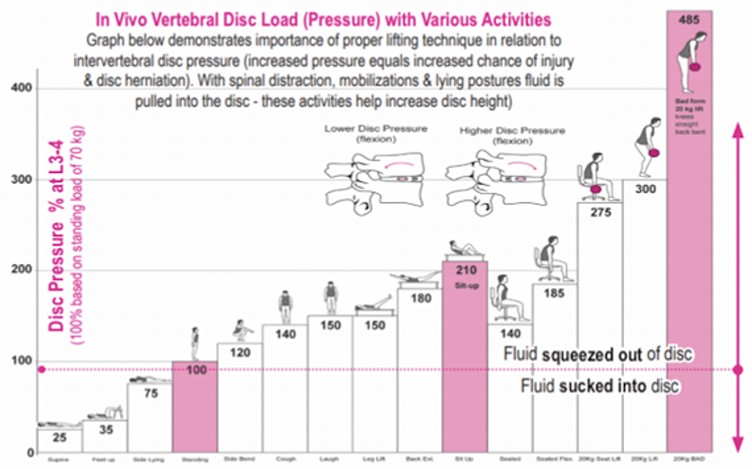
Dr. MacMillan offers this graph to demonstrate disc load (pressure) from standing to handling deadlifts. Photo: Kildahl, Blanchette, and Smith.
Tools To Address The Lean
So what should senior athletes do to address our posture and limit spinal stress? Dr. MacMillian shares his advice. “To correct our posture, there are a few things that need to be addressed.
Awareness & Running More Upright
The first is awareness, which this article will hopefully help to improve. Once you know something can be improved, you are empowered to improve it.
The second is the endurance of the muscles involved. If you tend to hunch or lean forward excessively, your body has probably adapted to this by strengthening some muscles and elongating others. This means that trying to run in a more upright posture will initially feel awkward and tiring until the muscles adapt”. As with any technical changes, try to incorporate them in short practice rounds that are gradually built up, and never during long or competitive events.”
Kinesio Tape
He continues, “Another tool that can be helpful is Kinesio tape (also known as K-tape). This stretchy adhesive fabric sticks to your back. If applied appropriately, it can keep your awareness of your posture. It is used all the time to prevent the usual postural slumping that occurs subconsciously in desk workers and others prone to postural imbalance.
It works by applying gentle but very noticeable pressure to your skin when you start to hunch forward, so you are always made aware of when you start to slip into a forward curve of the spine. The tape easily lasts an event and can last for a few days with many people. While it is best to have it applied by someone trained in its use (physiotherapist, kinesiologist, chiropractor, naturopathic physician), YouTube has many freely available videos on how to do this. Though it will need another person to help you, and probably some trial and error.”
Overall, “Correcting [your posture] can be a process. [It] should be done over time and with small outings rather than on long or competitive events so you can gradually and safely make the changes. Kinesio tape, simple core exercises, and knowledge can all be very helpful in improving posture and exercise efficiency. A well-trained, sports-focused therapist can help speed this process so you can get back to the fun faster, and with less pain and fatigue.”
For additional tools and techniques on how to prevent back pain when running and performing other activities, see the video below.
Approach 3: The Lovy Technique By Dr. Andrew Lovy
Fast Eddie, a senior athlete noted above and afflicted by The Lean, mentioned, “I am thinking of the best sports medicine doctor I have met. [I am] very fortunate to know [him] and helped by him at all major ultra races over almost 30 years. Dr. Andy Lovy. Andy, as I dare call him, has dug into all kinds of physical discomfort issues that runners suffer in ultras, included the dreaded lean.”
Dr. Andrew Lovy, arrived in America in 1940, at age five from Budapest, Hungary. He enjoys a curriculum vitae that could hold its own as a single article. Instead, here is a short version: He completed his Post Graduate Internship in 1962-1963 at Mount Clemens General Hospital, Michigan. Then, most recently, he acted as the Official Team Doctor for the 24-hour US World Championship Team (2007-2017).
Additionally, he has served as Clinical Adjunct Professor at Lincoln Memorial University and DeBusk College of Osteopathic Medicine (2008), an Honorary Life Member, American Academy of Osteopathy (2013), and Medical Director Preferred Health Care, Missouri (2017). Finally, what may be the most unusual, but a favorite position was the 2013 Official Doctor for the all-female Kirksville Viqueens, a flat track Roller Derby team.
The Lean Has A History
Dr. Lovy shares, “The lean has been a problem for many runners over the years, and I was told, once it develops, there is very little that can be done about it. I faced the issue about 15 years ago at Surgerres when Roy Pirrung, a champion masters ultra runner, developed it. I could get rid of it for a while, but it kept coming back, so what I was doing was only temporarily reducing it.”
He continues, “I began to study the phenomena at greater length, read everything about running mechanics I could find. [I] took biomechanical courses on gait mechanisms and the biochemistry of muscles as they fatigue and why those particular muscles are involved. Eventually, [I] found a better solution and was able to minimize and, in some cases, completely eliminate it for an event. I tried my technique on many runners and, at a few 24-hour races, provided medical care to many runners. I used my newly found technique on some who leaned and did everything I could.”
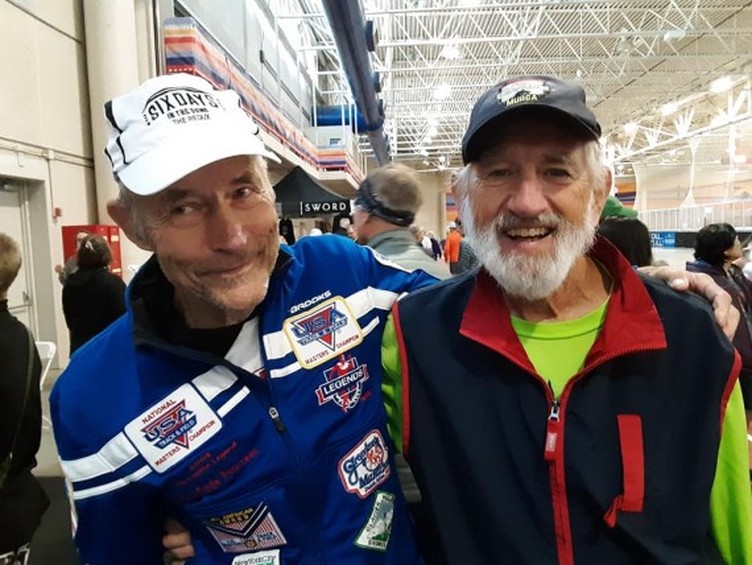
Jimmie Barnes, fellow athlete, (right) with “Fast Eddie” Rousseau. Photo: Kildahl, Blanchette, and Smith.
The Lovy Discovery
But, not on all. He found that those senior athletes who were administered the technique stopped leaning. Then, “The others continued leaning during the event. I taught it to some of my medical students who accompanied me to 24 and 48-hour events, and they too had success, so we know it works.
He continues, “Now the hard part. And this is more my theory than proven fact, but the theory is about as good as anyone else’s until a better theory evolves. Those who lean, lean in the same direction when it happens, regardless of the direction of the course. So it is more a muscle issue of the individual than fatigue in muscles resulting from the direction of the course.
My theory is that some muscles and usually the same muscles in that individual selectively run out of potassium, causing those muscles to stop firing. When that happens, the muscles on the other side still fire normally, causing the body to lean in the direction of those muscles that are still firing. Adding potassium does little when it happens, and the athlete continues to lean. I studied the firing sequence and read more literature on that and discovered that the sequence had been permanently altered for that event and needed to be reversed, and the sequence had to be ‘reset.'”
Luckily for all senior athletes out there, Dr. Andy Lovy discovered that he could reverse The Lean.
The Lean & Pressure To The Gluteus Muscles
Dr. Lovy notes the importance of the gluteus muscles in recovery from The Lean. Gluteus muscles are the muscles of the buttocks. They stretch from the back portion of the hipbone to the top of the thighbone. Or, as Dr. Lovy puts it, “There is a plexus of nerves or a nerve itself under the Gluteus minimus that is a controlling factor. Putting the person on their stomach, palpating under the gluteus maximus, then under the gluteus medius, until one gets to the Gluteus minimus on the side of the direction of the lean is the key”.
Once on the muscles, “Direct pressure on that area for about 30-40 seconds seems to reset the sequence. Then we do the standard stretch routine on that part of the body, [and] give them supplemental potassium or a banana. [Then], the person, within a half-mile, stops leaning, and usually for the balance of the event. Sometimes not, and we have to do it again. It seems to work every time.”
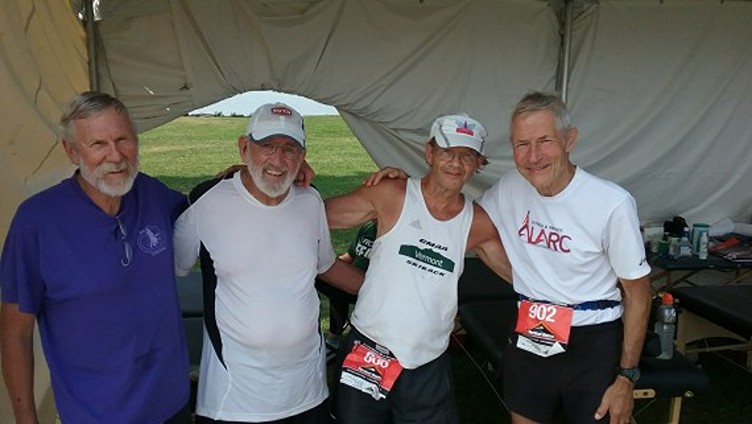
Not all lean is forward. (Left to Right) Jim Fiste, Jimmy Barnes, Newton Baker, Fast Eddie Rousseau. Photo: Kildah, Blanchette, and Smith.
However, the process is different for each senior athlete. “At the Six-Day Dome (ultra-race), there was a lady who leaned quite badly after just eight hours. We applied the technique that helped, but the lean returned in a few hours. Did it a second time with the same results, and the same thing happened. I tried it one more time and felt that this would be one person where the technique failed. I did notice, however, that by day two, the lean was completely gone and did not return for the rest of the (event), resulting in her winning her age group. We also used the same technique on others and stopped the lean, so I know we are on to something, but still working on perfecting the technique. So far, we have found that the earlier we can get to it, the better the results.”
Continual Improvement On The Technique
There is a continual improvement on Dr. Lovy’s technique as well. He notes, “Dr. Snyder, the Chair of OMM at ATSU, has shown me another trigger point on the innominate bone (think hipbone .Ed) that should have the same effect, so we are trying that one out as well. Not ready to publish, but I am doing it and have trained many of my students in the technique, and they all report success in preventing or minimizing the lean.”
Also, senior athletes should keep a lookout for susceptibility to the Lean. Dr. Lovy emphasizes that the sooner The Lean is discovered, the better. “On some athletes that we know lean, we work on them the night before, or if possible before the event begins. We use the same technique, and in some, it has prevented the lean from developing. There is more, of course, but this is a start. My theory may be flawed, but the techniques do work.” And that’s how the Lovy Technique came to be.
Approach 4: The Backward Stretch
Consulting with a physician who works with professional teams in the Twin Cities area (and must remain incognito), the advice offered falls into the category of, oops, a “backward stretch.”
The idea expresses as a cancellation of the effect of The Lean. Another way to view this, think a reverse-lean, one that forces muscles and bones to counteract the typical forward lean. Stretch back as far as you can without tipping over while allowing your hands to slide down the back of your legs.
Read More: Back To Basics: Back Exercises For Snowshoers
Approach 5: Anatomical Dysfunction By Dr. Jeff Kildahl
Dr. Jeff Kildahl scribes from coastal Rhode Island, but his heart beats for his beloved Rocky Mountains and Colorado. His practical wisdom continues not only as Snowshoe Magazine’s Wellness Editor but also with his forward-thinking company Performance Medicine®. Performance Medicine is “a visionary consulting firm providing trail runners and snowshoe racers synergistic solutions to genetically transcend wellness, performance, and potential in life and sport.”
Biomechanical Fluidity Is A Synergistic Process
He explains, “This process includes nutrition planning, nutrient timing, supplementation, strength training, cardiovascular training, kinesthetic training, sleep/regeneration, mindset, apparel, gear, accessories, apps, wearable technology, recovery, and the rest of it.
The focus of attaining effortless, powerful running for years was the foot strike. The typical running gait includes both supination and pronation or placing weight on both the outside and inside of your foot. Foot strike, stance, and swing are essential components. However, balance, awareness of the position of your pelvis, and actively moving forward the gluteus muscles create an efficient running stride.
Runners and sport snowshoers need to focus on their hips and core if s/he is interested in optimizing biomechanical fluidity, maximizing speed, and mitigating injury. The cause [pelvic region] versus the effect [foot strike] of the kinetic whip ought to predominate performance enhancement goals.
The Price of Our Lifestyles
Cause and effect play significant roles in sabotaging our exertion, thanks to environmental factors. As we run, each stride must go through an eccentric (muscle lengthening) phase before any concentric (muscle shortening) phase as muscle lengthening activates muscle shortening.
However, our lifestyles expose our biomechanical running and snowshoeing inefficiencies and compromise our performance. As noted above, a phenomenon termed “runners lean” has increasingly grown amid our sacred running and snowshoeing venues.
Prolonged sitting has infiltrated our daily lives to the point of becoming our performance demise. Thus, the Lean could be yet another by-product of our lack of awareness in other disciplines. The culprit: “Gluteal Amnesia.
Prolonged Sitting & The Impact On Our Muscles
Gluteal Amnesia is when your gluteal region “forgets” how to properly activate muscle contraction. Sitting for hours each day shortens and tightens hip flexors and deactivates our powerful gluteal muscles – especially when we need propulsion on the trails!
This concept of reciprocal inhibition is when one muscle group (hip flexors) creates length in its opposing muscle group (glutes). The occurrence of this concept cancels activation of the compromised muscle group – resulting in neurons that misfire or fail to fire – and the compromised muscles fail to contract.
The repetitive nature of running and snowshoeing makes the tightening of our hip flexor muscles worse. As noted above, we cannot expect a muscle to shorten without first lengthening. Therefore, if your gluteal nerves and muscles fail to function correctly, the rest of your body will be adversely impacted.
Proper gluteal activation is critical because it helps to stabilize the pelvis, and the biomechanics of the lower extremities depend on this stability. Lost elasticity of the muscles from prolonged sitting or inactivity can lead to a lack of strength and mobility in the gluteal plexus.
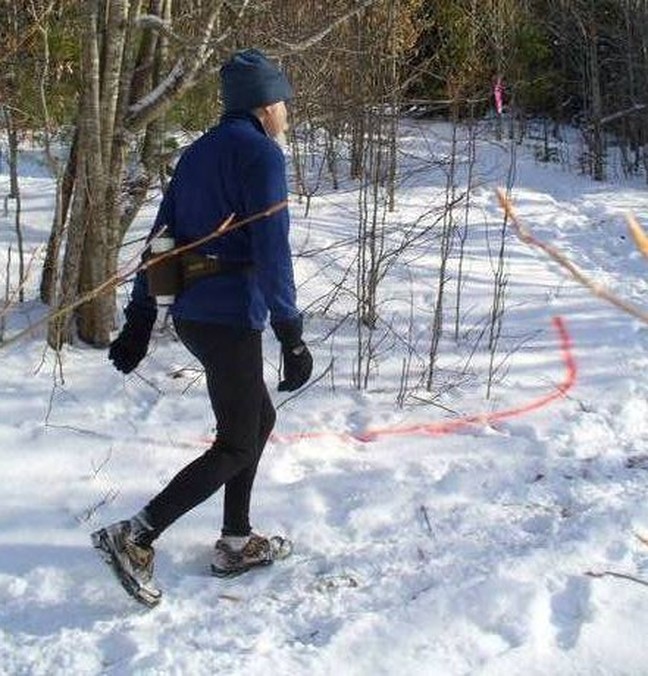
Ed Raymaker, the “Gordie Howe” of snowshoe racing in Maine, proves too quick for the cameras. Photo: Phillip Gary Smith.
Furthermore, an inactive gluteal region will cause an array of insidious postural and performance issues such as altered running gait, imbalances, asymmetrical firing patterns in the gluteal plexus, hips, and lower extremities, lower back pain, neck pain, spinal trauma, and more.
Poor posture (pelvic versus ankle lean) typically occurs in varying degrees and angles. Poor posture could be due to the hamstrings compensating for the deactivated gluteal musculature, overstriding versus increased cadence, and short stride length, shallow (chest) versus deep (diaphragmatic or nasal) breathing, and so forth.
Potassium As A Co-conspirator
Along with the impact prolonged sitting has on The Lean for senior athletes, potassium also plays a role. Potassium is the primary mineral located inside the body’s cells (intracellular) and stored in muscle fibers along with glycogen. It plays a critical role in transporting glucose into the muscle cells.
Potassium assists in the conduction of nerve impulses and interacts with both sodium and chloride to regulate fluid and electrolyte balances. When glycogen breaks down to supply energy for exertion, muscle cells are depleted of potassium.
Potassium is critical to “reset” the nerve for the next contraction or activity. It profoundly impacts sports performance in the following ways:
- Blood pressure;
- Muscle contractions;
- Nerve resets;
- Fluid/nutrient regulation;
- Energy production (ATP – adenosine triphosphate)
Potassium is essential to the process of breaking down glycogen in the muscle cells, which helps with repeated muscle contractions during endurance exercise. Glycogen is broken down, and the muscle cells are depleted of potassium before it enters the bloodstream and leaves the body via urination or sweat.
To maintain your level of performance, a system termed the sodium-potassium pump is critical. It is the process of transporting potassium and sodium to produce energy.
Maintaining Your Metabolic Efficiency
The first nutrition limiter to endurance sports performance is depleted glycogen stores. One key to peak performance is Metabolic Efficiency™. This concept demonstrates sports performance excellence because of your diet, not in spite of it. A by-product of metabolic efficiency™ is its innumerable benefits respective to health markers.
Metabolic Efficiency™ is the body’s ability to utilize endogenous stores of carbohydrate and fat at varying intensities and duration of exercise and rest.
Elevated blood sugar or a sodium-potassium imbalance will incite mayhem such as an imbalance of free radicals and antioxidants in the body, impaired protein processing, lack of oxygen to the body, and deactivation of the “firing sequence” of the gluteal musculature.
Read More: Metabolic Inefficiency & Impact On Your Peak Performance
The Law of Polarity: Inversion As A Tool For The Lean
The key to running and snowshoeing biomechanical fluidity is to address issues with balance, awareness of the position of your pelvis, gluteus muscles, and the environment factors sabotaging your desired outcomes.
Only strengthening your gluteal musculature via jump training, squats, yoga, and other modalities are not enough. Being mindful of your joints, muscles, alignment, and so forth is integral to optimizing performance and mitigating injury. One must “feel” the balance and propulsion from his/her core region and mindfully merge breath and posture each foot strike.
Inversion imparts more than merely hanging upside down. The degree to which you invert is dependent upon your needs and acclimation tolerance.
It is typical practice to invert 20-30 degrees for a few minutes each session and adjust to full inversion (90 degrees) through gradual progression and consistency. Most health care practitioners recommend intermittent traction or oscillation.
Inversion offers endurance athletes, senior or otherwise, a lightweight, easy-to-use method of optimizing your physiology. Hanging upside-down may incur mind-blowing perspectives on more than just running or snowshoeing.
Inversion therapy may be a plausible preventative and recovery option to mitigate precursors to “runners lean” in a few sessions per week. Find below a few benefits:
- Strengthens ligaments;
- Improves posture;
- Elongates your spine;
- Reverses effects of gravity;
- Elongates core to promote better posture;
- Promotes proficient muscle firing;
- Thwarts muscle spasms;
- Improves lymphatic flow;
- Increases circulation;
- Corrects hip alignment;
- Enhances oxygenation;
- Improves capillary proliferation;
- Enhances blood flow to muscles/tissue;
- Relieves inflammation – joints, hips, muscles;
- Elongates muscle fibers;
- Restores harmony to vital organs;
- Improves the integrity of fascia, muscles, and connective tissue;
- Relieves muscle tension;
- Strengthens joints and ligaments;
- Enhances joint decompression;
- Relieves stress;
- Normalizes ear canals;
- Improves balance;
- Varicose veins treatment;
- Increases hip flexion;
- And much more.
Supplemental Inversion Exercises & Tools
In addition to inversion, athletes can include a variety of exercises on his/her table. Some activities that may provide further benefits include stretching, crunches, squats, extensions, and so forth. There is an extensive list of accessories available from handles, tether straps, foam pads, and the like depending on the manufacturer.
Prices for inversion equipment vary dramatically among manufacturers and distributors. There are several discounted inversion tables and chairs available from online distributors such as Zearth.com, AllegroMedical.com, and so forth. Specialty retailers, like Better Back Many stores sell versions of these products priced $500 and more. HSN.com features Teeter Hang-Ups—long considered the benchmark for inversion products—at a reduced cost ($299) via monthly payments with shipping included plus instructional videos.
Check with specialty retail outlets, physical therapy centers, chiropractors, and other health care practitioners to test inversion after receiving approval from your physician. You will notice its benefits within minutes at any angle.”
Read More: Don’t Forget To Stretch For Snowshoeing
Approach 6: Kettlebell Swings
The Kettlebell invasion of the USA led to a new and distinctive method to strengthen one’s core. With a strong midsection, your body holds you upright. Without it, you slump and clump.
Furthermore, Kettlebell swings direct attention right to your hips and mid-body if performed correctly. Swings are not moving the weight with your arms back-and-forth. Instead, one uses their hip (and therefore all its muscles) to push and launch the kettlebell forward to then glide back through split legs. This video from Bodyfit by Amy provides a thorough visual for best practices.
Using Kettlebells for this purpose may take five minutes max. So the excuse “I haven’t the time” gets thrown out the window. Your Excuse Tray is now empty, so go after it. When you’re racing a long competition, you can thank your “Hell’s Bells” for Kettlebells as your posture now defines the word “straight.” As you practice, continue extending the time involved and the ability to keep the motion going.
Read More: Kettlebell Training: The Snowshoe Racer’s New Friend
Overall: Finding A Solution For The Lean
The Lean, at times, works to a competitor’s advantage. “Fast Eddie” gave this account of the 2018 24-Hour Nationals, in Edgewater Park, Cleveland, Ohio. “Michael Haviland was well ahead of me and Newton when his painful lean came on. He had to go to his tent and lay down for several hours. At the time I recall, he’s at 60 miles (96 km), and I was at 52.
So I won that age-class Gold Medal with a nagging hamstring pain hampering my pace, but my back lean pain was tolerable, so I kept grinding out miles for the entire 24 hours. The dreaded lean moved me from third to first in the last 4 hours, proving the old adage in a 24 Hour Race, that ‘The race starts at 20 hours for those still standing.'”
Taking Action Against The Lean From All Ages
Take action to combat The Lean if you currently suffer it or are showing signs of succumbing to its jungle ways. “No lean for me, I’m just straight up and down” reads like a right attitude, but typically from a much younger athlete.
Dr. Lovy commented, “If one or more of those work for an individual runner, by all means, use it. I have seen many elite runners lose races and championships because of the lean. Much more study needs to be made to understand its mechanism and help runners either prevent it from happening or address it as soon as it happens”.
So, start now and avoid a roadblock standing in your way some time or somewhere down the pike. Help others to make sure they understand why they should be overjoyed to discover these techniques that may help with their problem. Go ahead; get mean with The Lean!
Read More:
Snowshoeing For Seniors: Into Your 70s and Beyond
Hidden Secrets! Preparing For A Snowshoe Distance Event
Have you ever had the Lean while snowshoe racing? What recommendations would you have for other senior athletes?
Dopamine’s Relation To The Lean
An excellent question was posed by a reader dealing with Parkinson’s Disease: “As you age, you produce less dopamine. Could it be that the dreaded lean comes not from your muscles but your brain?” We asked Dr. Jeff Kildahl his take on this, and how to deal with it. He wrote, “Dopamine certainly would impact a condition such as ‘The Lean.’ Dopamine is a hormone and a neurotransmitter.
PD is a disease in which low dopamine levels disrupt the brain’s ability to control body movements. More research is necessary to determine an exercise type, intensity, and duration that best boosts dopamine levels. Exercise several times per week has shown to improve motor control in people with PD.
Our bodies require several vitamins and minerals to create dopamine like iron, niacin, folate, and B6. L-tyrosine is a cognitive enhancer. Diagnostic assessments will identify any deficiency in said vitamins and minerals. Proper nutrition plus magnesium, vitamin D, curcumin, oregano oil/extract, green tea, probiotics, adequate sleep, sunshine, and natural food sources of L-dopa.
Some of those sources include:
–> Fava Beans;
–> Dairy;
–> Beef | Chicken | Turkey;
–> Omega-3s –> Salmon | Mackerel | Flax Seeds;
–> Eggs;
–> Fruits | Veggies [especially Bananas];
–> Almonds | Walnuts;
–> Dark Chocolate (yea! ed.)
Additional Sources:
–> EAAS (Essential Amino Acids)
–> Probiotics;
–> Increased Protein Intake;
–> Decreased Saturated Fat Intake;
Levodopa is a drug that does access the blood-brain barrier and is converted to dopamine.
Prescriptions incur side effects.”
Snowshoe Magazine Writers:
Dr. Jeff Kildahl Jeff@pmsynergy.com Twitter: @PM_Synergy
Christine Blanchette ChristineBlanchette@Hotmail.com Twitter: @ChristineRuns
Phillip Gary Smith Phillip@UltraSuperior.com Twitters: @iHarmonizing @UltraSuperior @TheEclectic18

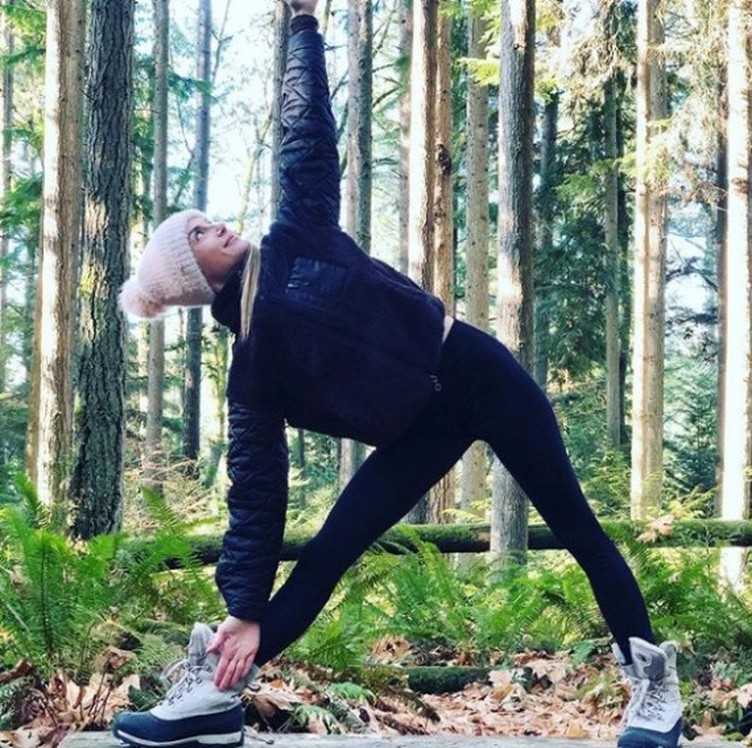
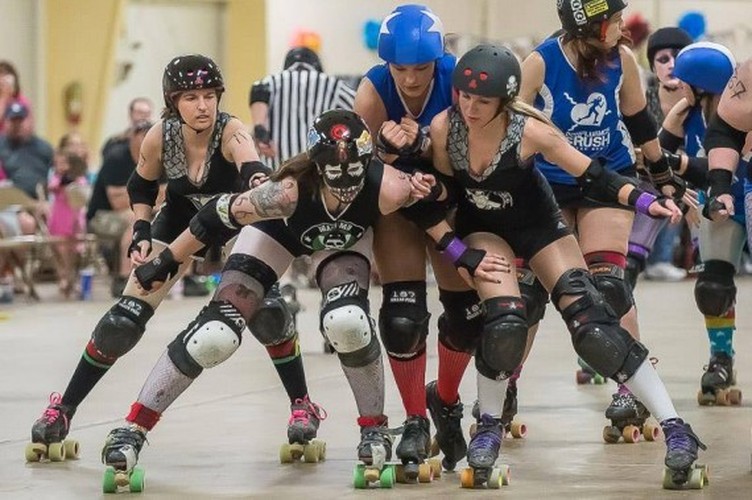
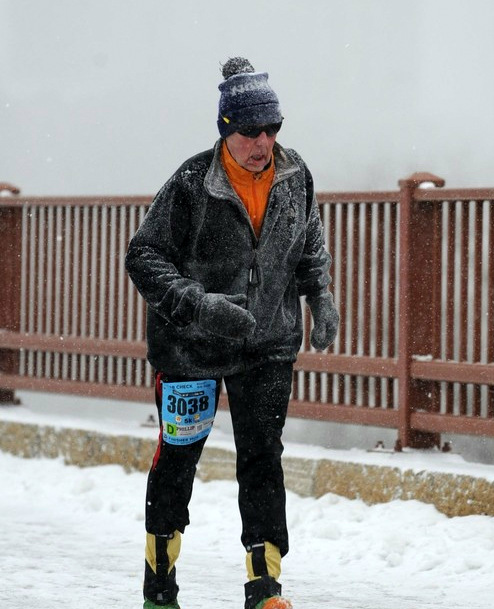
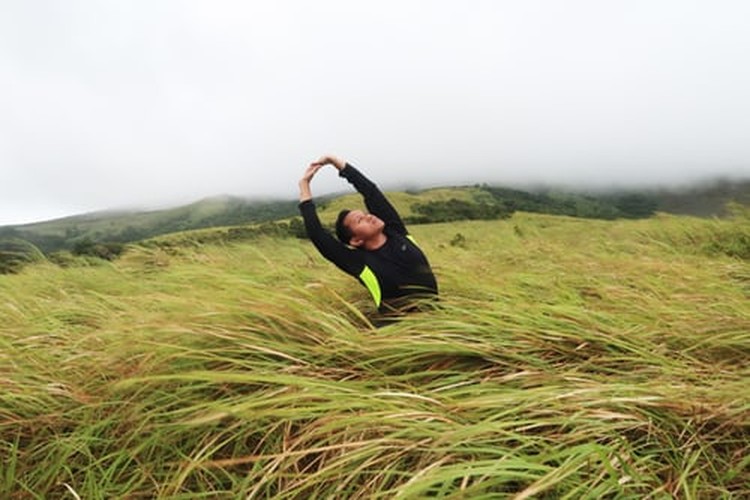
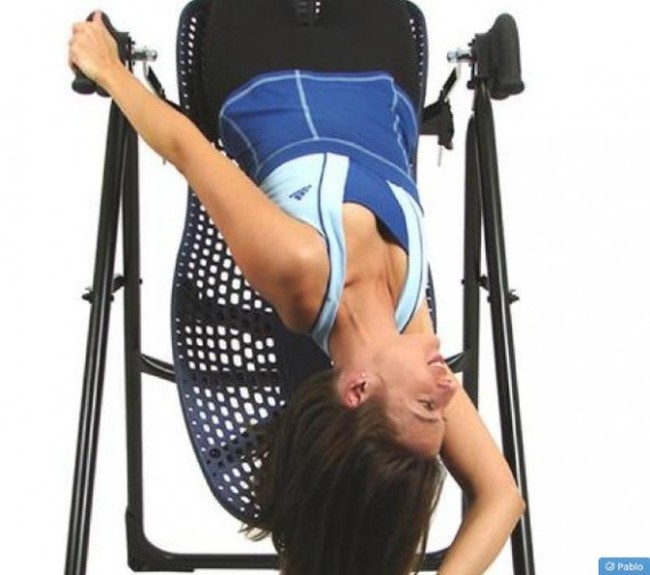
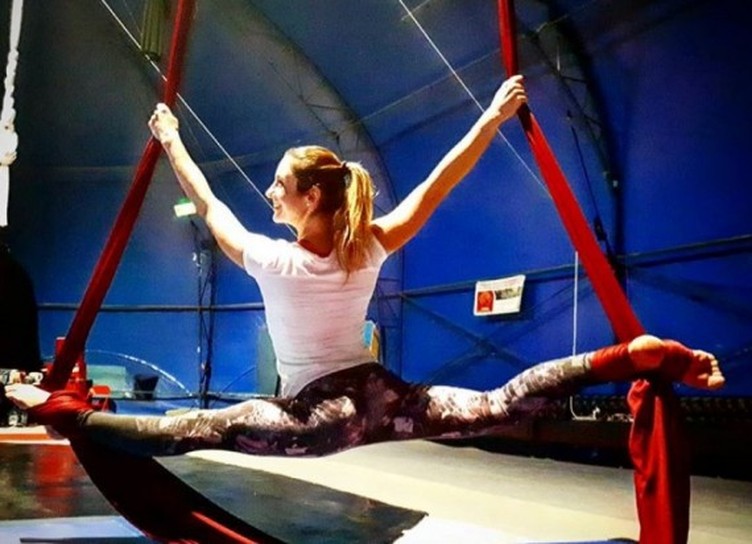

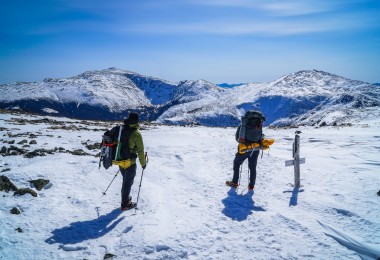
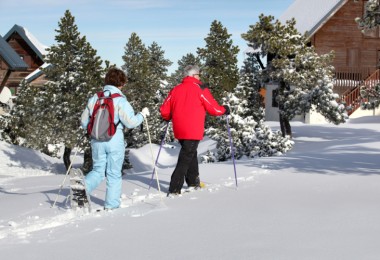
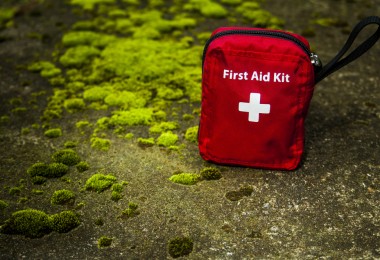
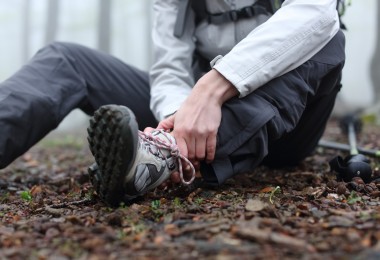

interesting but there is one area that might be worth research and that is the role of dopamine. I used to be a 2:50 marathon runner but was diagnosed with early onset Parkinson’s disease at 42. When my running deteriorated I turned to ultra walking. I have had PD now for nearly 16 years, I use a walking stick for balance. After walking 154 km in 24 hrs in 2018, I aimed to get my Centurion in 2019 (100 miles in 24 hours). I had trained intensely and went through 12 hrs just under 88 km, 100 km in 13:50, at about 16 hrs the lean started and everything fell apart. Research from race medicos later confirmed by my neurologist indicated Pisa Syndrome, an intense lean common to people with PD, Huntingdon’s disease and other neurological diseases (I actually tore a back tendon and was also crossing my legs over risking falling) For some with PD it’s a daily issue. Parkinson’s is caused by the part of the brain dying that produces dopamine, loss of dopamine causing symptoms such as tremor, muscle rigidity, movement interruption, slowness of movement, loss of balance & coordination, depression, apathy, lethargy….and a myriad of other issues and of course loss of posture, a stoop generally and Pisa syndrome in later stages or when under pressure. As you age you produce less dopamine could it be that the dreaded lean comes not from your muscles but your brain?
Thank you for sharing your experience, Linda! That is a very interesting idea and dopamine, as it relates to the lean, would definitely be worth further research. Since most research on the lean is still fairly recent and the lean affects every athlete differently, it will be interesting to see where the science takes us over the next several years.
DR Lovy has helped me 3 times with the lean. Thanks for the article and the photo op demonstrating the lean!
I’m so glad to hear that Dr. Lovy has helped you, Newton! The lean affects so many athletes, but I don’t think it’s really one of those areas often discussed. Thank you for sharing and I’m glad you liked the article 🙂
Thanks for this information I have been competing with Ed for many years and have often developed the lean Dr. Lovy was able to help me at 6 Days in the Dome with his technique. Your picture of Ed and Dr. Lovy is mislabled as that is me on the right.
That’s so great that Dr. Lovy was able to help you with his technique! Thanks for sharing Jimmie! I apologize that the picture was mislabeled. I’ve gone ahead and fixed it. 🙂